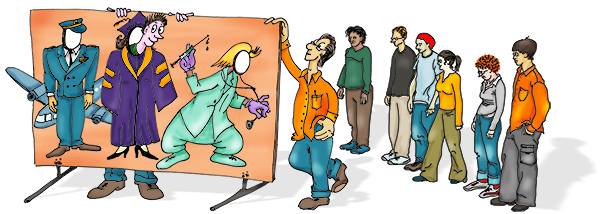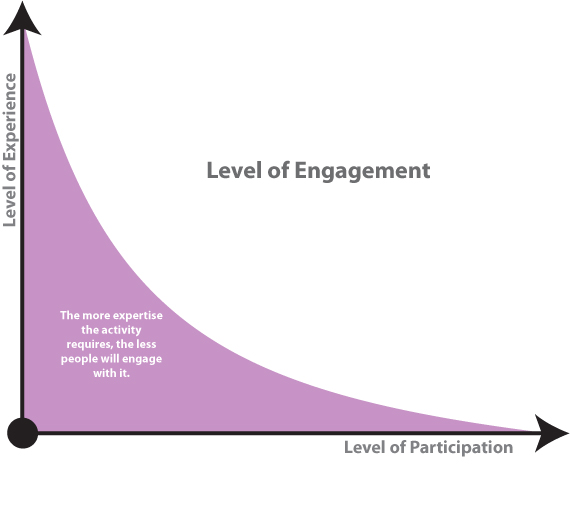We once had a client who made his secretary drive to our studio with a piece of a carpet from his office to be used as a color swatch for his company’s new logo. And while the final logo looked okay (very logo-like), it did little to represent the company’s brand. The company is no longer around today. Having a client who opines on the color of the background, choice of typeface, thickness of line, or layout mars the design process. It’s easy to get lost in details and personal preferences—who is to say that green is better than orange? A good designer has to be able to manage the client, keep the conversation focused on business goals and user needs. But before we can delve into the design process, we have establish trust. Clients need to feel like they’ve been listened to, they have to know and understand that design is hard work, and they have to buy into our expertise. The First Date The initial group meeting between the design firm and their client tends to feel like a first date: this is a chance for everyone to declare their expertise and expectations of each other. And like a…
Cognitive Blindness
Inability to really know how others think and how their cognitive processes are different from our own.
Attention Controls Errors, Cognitive Blindness, Conceptual Design, Featured, Interaction Design, Mode Errors, Pipsqueak Articles, Users
Skin-deep Usability
by Olga Werby •

The Universal Remote Control Story A few years ago, we got a Star Trek phaser universal remote control as a gag gift for the holidays. As any universal remote control (URC), it was supposed to control any and all devices that were hooked up to our TV and do it with a flair of shooting a phaser at the general direction of our equipment. A few days later, it was relegated to our sons’ toy box, and now I wouldn’t even know where to look for the thing. Big buttons, footballs, phasers, UFOs, futuristic control centers—the makers of universal remote controls have tried them all. But consumers still buy one URC after another in the hope of finding something that would work for them. Why are these things so darn hard to use? Manufacturers seem to believe that by giving their products a friendly, toy-like appearances, these devices would seem more user-friendly and easier to use. But, personally, I don’t want a giant ball in middle of my kitchen table or rolling around my living room floor. I don’t want the kids to toss footballs to control the channels or fire phasers to lower the sound. I just want something…
Cognitive Blindness, Conceptual Design, Cultural Bias, Cultural Differences, Ethnographic & User Data, Featured, Interaction Design, Interface Design, Mirroring Errors, Pipsqueak Articles, Users
Be the Customer
by Olga Werby •

By our very nature, humans are an “us versus them” kind of mammal. We are quick to judge and categorize: “he’s our kind’a people” or “she’s management.” We adapt and root for our favorite sports teams, sometimes even resorting to violence to “defend our guys.” We peg an art department against the engineers; we side with nurses over doctors; we fight with democrats against republicans; we wave our flags in a spirit of nationalism. And it doesn’t matter if we all work for the same company, heal the same patients, want the same basic rights, or live on a very small planet—we tend to take sides. So it’s no surprise that when product designers develop products the feeling of “us against the users” creeps up into the process. To protect the design process from these “us versus them” impulses, we can create a well-realized user personas based on the the audience taxonomy developed during the conceptual design stage of product design. For each major category in the audience taxonomy, a sample fictional user is created which embodies all of the traits in that audience category: age, profession, socio-economic background, culture and sub-culture, interests and dislikes, family status, education level, etc.…
Background Knowledge, Background Knowledge Errors, Cognitive Blindness, Pipsqueak Articles, Product Design Strategy, ZPD
Science vs. Media: Degree of Public Involvement
by Olga Werby •

Recently, there has been an explosion of public discourse (fueled by the media) on whether we should do away with tenure in our institutions of higher learning. The basic argument boils down to “tenured teachers can do as they please due to job security and education suffers as the result.” Tenured professors, we are told, focus on research and publishing incomprehensible articles aimed at a few individuals in the world who could even understand them. What’s the use in that, people ask? My son/daughter/neighbor’s kid are being taught by a TA (with poor language skills) while we pay thousands of dollars for the privilege of these children attending universities with all those lazy good-for-nothing tenured professors! You might say that my summary of this world-view is extreme and simplifies the ideas to their comic representation. But that’s the point: the articles (and the readers’ comments they inspire) are written to get an emotional response. The issues of tenure, of the research that these tenured professors are engaged in and the articles they publish, and of teaching styles are complex. To evaluate the contribution of a scientist to his field, one needs to have a certain amount of expertise in that…
Cognitive Blindness, Cultural Differences, Ethnographic & User Data, Personality, Pipsqueak Articles
We’re Only as Happy as Our Unhappiest Child
by Olga Werby •
Recession is an interesting prism by which to examine our modern society. The scarcity of jobs a century ago, led to an abolishment of child labor, an extension of the educational system to accommodate these out-of-work children, and a development of new laws to serve them. Most importantly, dire economic conditions were the direct cause behind the “discovery” of a new stage of life: adolescence. The current economic hardship is particularly difficult on the 18 to 30 demographic. These “adults” are struggling to find jobs, life-long relationships, educational opportunities, and self-fulfillment. The term failure to launch is coined to describe the restlessness and ambiguity felt by this population. Dr. Jeffrey J. Arnett describes this phase of life as emerging adulthood: “Instead of entering marriage and parenthood in their very early twenties, most people now postpone these transitions until at least their late twenties, and spend their late teens through their mid-twenties in self-focused exploration as they try out different possibilities in love and work. Essentially, a new developmental stage has been created between adolescence and young adulthood.” [http://www.jeffreyarnett.com] Dr. Arnett discusses the internal traits that define his newly-proposed phase of life: identity exploration instability in work, relationships, living circumstances self-focus…
Cognitive Blindness, Errors, Featured, Interface Design, Perception, Pipsqueak Articles
Color Blind Design
by Olga Werby •

Do you see any difference between these two images? About 10% of the male population (with up to 20% among some ethnic groups) do not. Do differences in the way individuals perceive and process color information matter? Sometimes… Consider this informational graphic: It’s easy to see how the information contained within this chart has been transformed and no longer carries the same meaning. Which is the right one? When designing information for communication, it’s important to consider the totality of the intended audience: What are their strength? What are their limitations? Like cognitive traits, perceptual differences have to be accommodated by good design. Some issues that individuals with deuteranope deficit (red/green confusion) face is inability to tell the difference between colored items that are too thin (lines), point sources, and blinking lights (think traffic lights blinking green or yellow). These problems effect real-life performance and can lead to accidents: think traffic light color confusion. It is the job of a product designer to reduce the difficulties these individuals face. You can use this URL to check your site for color blind usability: http://www.vischeck.com/vischeck/vischeckURL.php
Cognitive Blindness, Conceptual Design, Contributor, Ethnographic & User Data, Interaction Design, Perception, Personality, Product Design Strategy, Users
On “Flattery Will Get You Far”
by mwaters •
Article: Valdesolo, P. (2010). “Flattery Will Get You So Far.” Scientific American Online, Scientificamerican.com. Retrieved on 30 June 2010: http://www.scientificamerican.com/article.cfm?id=flattery-will-get-you-far Summary: Its not uncommon for people to kiss up and flatter others in their everyday lives, with the hopes that such remarks will get them what they want. Many times these motives are easily recognized and written off as insincere. However it’s quite possible that the effects of such flattery are more powerful than we think. Researchers are taking a deeper look into how blatant flattering influences consumer loyalty and sales. A study conducted by the Hong Kong University of Science and Technology found that consumers exposed to a department store’s advertising campaign, commending shoppers on their sense of style, were likely to continue making purchases at the store. Furthermore, these consumers, who explicitly expressed their awareness of the stores attempt to manipulate behavior through flattery, were likely to join the store club. Researchers believe this type of flattery works by reinforcing the above average ideas that individuals reserve for themselves, as well as increasing esteem in areas where some feel low. The article suggests that positive images in advertising, when linked to products, might also subconsciously influence consumer desire…
